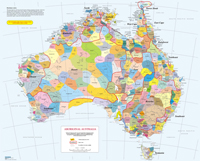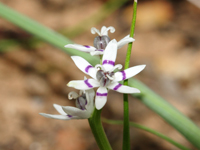Early this afternoon I ventured into an area north of Bells Lane Track that had been subject to a recent planned burn, a few weeks back in mid-autumn.
In past years this patch has produced Rose Robin, Red-capped Robin, Scarlet Honeyeater, Painted Button-quail as well as a bunch of other interesting woodland birds.
Birds were scarce today. In addition to those pictured below I observed a Whistling Kite floating over the canopy, some Buff-rumped Thornbills and a White-throated Treecreeper. The activity in the unburnt patch immediately to the north was more rewarding with Crested Shrike-tit, Speckled Warbler, Scarlet Robin, Brown Thornbill, Grey Fantail, Superb Fairy-wren, with the species from the burnt patch also present. The autumn burn was obviously quite hot, with some canopy scorch, and it was no surprise that both diversity and abundance was lower when compared to the adjacent unburnt woodland.

Galah (female), Muckleford Nature Conservation Reserve, 1st June 2024

Peaceful Dove

Golden Whistler (male)

Golden Whistler (female)
Understanding of the long-term effects of planned burning on woodland bird communities is in its infancy. A recent meta-analysis (Gibson et al, 2021) produced some overarching findings:
- Bird species richness and abundance increased significantly with time since fire.
- When comparing burnt and unburnt sites, species response to fire was significantly influenced by fire type. Wildfire had consistently negative effects on bird species richness and abundance, whereas prescribed fire had no effect on species richness and mixed effects on bird abundance.
- Clear patterns of post-fire response for forest and woodland bird richness and abundance and underscores the need to incorporate long post-fire recovery periods into fire mosaic planning.
I’m motivated to undertake some more systematic surveys at this site to see what patterns emerge.
Reference: Gibson, M., Maron, M., Robinson, N., Walsh, J., 2021. Response of Australia’s woodland bird community to fire: a review and meta-analysis. NESP Threatened Species Recovery Hub Project 8.4.4 report, Brisbane .. you can access the link here.











One of your best @Geoff.
Yes that patch was particalrarly rich, it will be interesting to see how it recovers
Thanks for the link. My complaint is with DWELP and what I believe is their poor choice of the burns. The intersection of Mia Mia Trk & Sth German Trk is typical of poor choice. Sparsely vegetated but usually harbouring a variety of bird species such as you have indicated, I can’t see why a so called ‘cool burn’ has helped the area. The area was burnt several years ago but more recently there have been signs by an Indigenous group who intend to burn the area again.
I have conducted CC and MKBA bird surveys in this area for at least a decade and have noticed a decline in both variety and numbers of bird species. It’s not easy to prove that this is due to the burning as there are other things impacting the area such as the firewood harvesting, but I personally believe it’s due to the burning.
The nearby landowner badgers DWELP to conduct the burns in this area order to protect his property, however his property has huge amounts of blue gums and man made rubbish which is just as likely to be a fire hazard as the sparsely vegetated bushland.
Please continue your research into the impact of bush burn offs in our previous area. Let me know if you require some help with surveys.
Hi Sue.
Apologies for the slow reply.
The DEECA ‘cool burn’ north of Bells Lane Track (location of this post) actually turned out to be a hot burn and I predict it will generate significant wattle regrowth over the next year or two, thereby increasing fuel loads … a temporary reduction in risk (which can be argued) will soon become perhaps more elevated. The initial Mia Mia/South German burn was a separate exercise and pretty much failed to burn at all. Subsequently a cultural burn (Djandak wi) has been conducted by the Dja Dja Wurrung team and in my view this has been more useful from an ecological perspective although time will tell. I’m currently helping CC analyse some of their bird data, including your survey data and while I suspect this will be inconclusive about the effect of fire at this stage, in the longer term it will help with our understanding. I’d be happy to have a yarn at some stage to discuss the surveys. All the best, Geoff